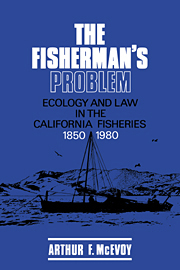Book contents
- Frontmatter
- Contents
- List of figures
- List of tables
- Preface
- Acknowledgments
- List of abbreviations
- Introduction
- I The miner's canary
- II Sun, wind, and sail, 1850–1910
- III The industrial frontier, 1910–1950
- 6 Mechanized fishing
- 7 The bureaucrat's problem
- IV Enclosure of the ocean, 1950–1980
- Conclusion
- Appendixes
- Notes
- Selected bibliography
- Index
6 - Mechanized fishing
Published online by Cambridge University Press: 06 January 2010
- Frontmatter
- Contents
- List of figures
- List of tables
- Preface
- Acknowledgments
- List of abbreviations
- Introduction
- I The miner's canary
- II Sun, wind, and sail, 1850–1910
- III The industrial frontier, 1910–1950
- 6 Mechanized fishing
- 7 The bureaucrat's problem
- IV Enclosure of the ocean, 1950–1980
- Conclusion
- Appendixes
- Notes
- Selected bibliography
- Index
Summary
I have myself seen the carrier pigeon so that you couldn't see the sun. There isn't a species left in the world. The commercialism is responsible for their entire disappearance from the earth. … If the reduction plants are permitted to take sardines from the ocean ad lib it is only a question of time, I do not know how long, until there wouldn't be any left.
– F. E. Booth (1925)The sardine, Mr. Duke, some year they come lots, some year they don't come lots. Every year they come enough to work in the canneries.
– Peter Ferrante (1925)Elmer Higgins was ten years old in 1902, when his family moved from Iowa to Long Beach, California. Some thirty years later, testifying to a Congressional committee in his capacity as Chief of Biological Inquiry for the U.S. Bureau of Fisheries, Higgins recalled that as a boy he could drop a fishing line off the end of Long Beach Pier and, with a single pull, snag as many as two or three sardines on an unbaited hook. Shoals of the fish, one or two feet beneath the surface and six feet thick, blackened the water of Long Beach Harbor as far as he could see. Earl Pomeroy, an historian who grew up in Santa Cruz during the 1920s and 1930s, likewise remembered that he could mark schools of sardine on the horizon by the dark clouds of seabirds feeding on them. Both men reflected that, without realizing it at the time, they had been witness to an era in the state's ecological history that was passing even as they watched.
- Type
- Chapter
- Information
- The Fisherman's ProblemEcology and Law in the California Fisheries, 1850–1980, pp. 123 - 155Publisher: Cambridge University PressPrint publication year: 1986

